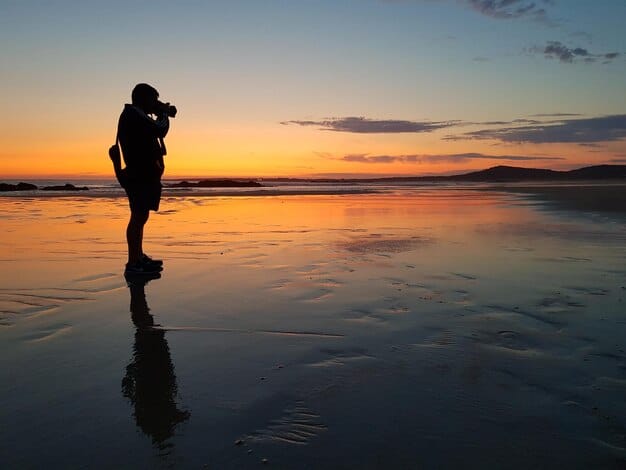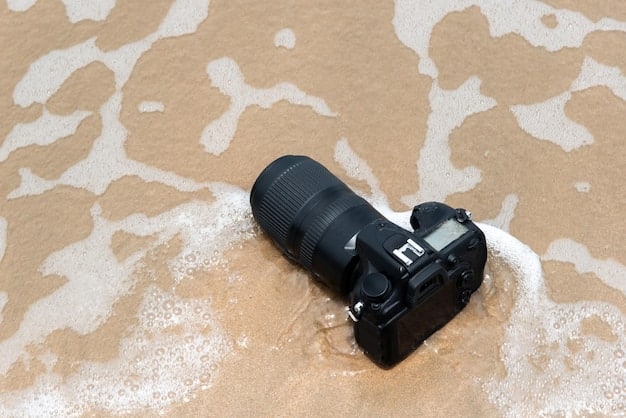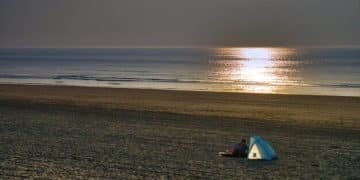Beach Photography Tips: Capture Stunning Memories

Beach photography tips involve understanding lighting, composition, and weather to capture stunning memories, ensuring you make the most of your beach trip with unforgettable, high-quality photos.
Planning a beach trip? Don’t forget your camera! These beach photography tips: capture stunning memories on your next trip, will help you bring home more than just a suntan – you’ll have breathtaking photos to cherish forever.
Essential Gear for Beach Photography
Beach photography requires different equipment to handle the harsh environment and varying lighting conditions. Having the right gear can significantly improve your chances of capturing stunning images.
Camera and Lens Choices
Selecting the right camera and lens is crucial for beach photography. A DSLR or mirrorless camera offers the most flexibility and control, but even a high-quality smartphone can work in a pinch.
- DSLR/Mirrorless Camera: Provides manual controls, interchangeable lenses, and higher image quality.
- Wide-Angle Lens (16-35mm): Great for capturing expansive landscapes and seascapes.
- Telephoto Lens (70-200mm or longer): Ideal for zooming in on distant subjects or wildlife.
Think about bringing a versatile zoom lens that covers wide to telephoto ranges (like a 24-105mm) if you want to travel light. Protecting your gear is also critical.

Mastering Lighting Conditions
Lighting is arguably the most critical element in beach photography. Beaches present unique challenges due to the intense sunlight and reflective surfaces.
Golden Hour Magic
The golden hour, the period shortly after sunrise and before sunset, provides soft, warm light that is ideal for photography. During this time, the light is less harsh and creates beautiful, flattering tones.
Aim to shoot during these times to capture the most flattering and visually appealing images. The light will be soft, creating warm tones and long shadows, perfect for portraits and landscapes alike.
Dealing with Harsh Sunlight
Midday sun can be the enemy of beach photographers due to its harshness and tendency to create strong shadows. However, with the right techniques, you can still capture great shots.
- Use a Diffuser: Softens the light and reduces harsh shadows on your subject.
- Shoot in the Shade: Position your subject in the shade of a building or large object.
- Embrace Overcast Days: Overcast days provide soft, even lighting, perfect for portraits and detailed shots.
If you must shoot in harsh sunlight, consider using fill flash to balance the light and reduce shadows on your subject’s face.
Composition Techniques for Stunning Shots
Composition is the arrangement of elements within your photograph. Effective composition can transform a simple scene into a captivating image.
Rule of Thirds
The rule of thirds involves dividing your image into nine equal parts using two horizontal and two vertical lines. Place key elements along these lines or at their intersections to create a balanced and visually appealing composition.
This technique helps to draw the viewer’s eye to the most important parts of the photo, creating a more engaging image.
Leading Lines
Leading lines are lines within your image that guide the viewer’s eye towards the subject. On a beach, this could be a shoreline, a row of beach umbrellas, or a pathway.
By strategically incorporating leading lines, you can create a sense of depth and direct the viewer’s attention to the focal point of your photograph.

Capturing Action and Motion
Beaches are dynamic environments, offering plenty of opportunities to capture action and motion.
Freezing the Action
To capture sharp images of moving subjects, you need to use a fast shutter speed. A shutter speed of 1/500th of a second or faster is generally adequate for freezing most action.
Creating Motion Blur
Conversely, you can use a slower shutter speed to create motion blur, conveying a sense of movement and speed. This technique works well for capturing waves crashing or people running along the beach.
- Use a Tripod: Essential for keeping your camera steady during long exposures.
- Experiment with Shutter Speeds: Try different shutter speeds to see how they affect the motion blur.
- Follow the Subject: Pan your camera with the moving subject to keep it relatively sharp while blurring the background.
A neutral density (ND) filter can help you achieve slower shutter speeds in bright conditions by reducing the amount of light entering the lens.
Creative Beach Photography Ideas
Beyond the standard beach shots, there are many creative ways to capture unique and memorable images.
Silhouette Photography
Silhouette photography involves capturing subjects against a bright background, such as the setting sun or a bright sky. This technique creates dramatic and striking images.
Position your subject so that it is backlit by the light source, and ensure that your camera settings are adjusted to expose for the background, not the subject.
Reflections in Water
After a rain shower, puddles on the beach can provide fantastic opportunities for capturing reflections. Look for interesting subjects to reflect, such as people, buildings, or the sky.
- Get Low: Position your camera close to the ground to capture the full reflection.
- Use a Wide-Angle Lens: Helps to capture more of the scene in the reflection.
- Pay Attention to Composition: Experiment with different angles to find the most visually appealing composition.
Reflections can add an element of surrealism and beauty to your beach photography.
Protecting Your Equipment
The beach can be a harsh environment for camera equipment, with sand, saltwater, and intense sunlight posing significant risks.
Sand and Saltwater Protection
Sand and saltwater can damage your camera’s internal components and scratch your lens. It’s essential to take precautions to protect your gear.
- Use a Camera Bag: Keep your camera in a bag when not in use to protect it from sand and spray.
- Use Lens Filters: Protect your lens with a UV or protective filter.
- Clean Regularly: Wipe down your camera and lens with a soft, dry cloth after each use.
Consider using a waterproof camera or a waterproof housing if you plan to shoot near the water or in wet conditions.
Sun Protection
Intense sunlight can overheat your camera and damage its sensor. Avoid leaving your camera in direct sunlight for extended periods.
Use a lens hood to block stray light and reduce glare, and consider storing your camera in a cooler or insulated bag to keep it cool. Be mindful of your own sun protection as well.
| Key Point | Brief Description |
|---|---|
| 📸 Gear Choices | Use DSLR/Mirrorless for flexibility; wide & telephoto lenses recommended. |
| ☀️ Golden Hour | Best light after sunrise/before sunset; soft, warm tones. |
| 🌊 Action Shots | Freeze motion with fast shutter; motion blur with slow shutter on tripod. |
| 🛡️ Protection | Shield equipment from sand, saltwater, sunlight; use bags, filters, avoid direct sun. |
Frequently Asked Questions
▼
The best times are during the golden hour, shortly after sunrise and before sunset, when the light is soft and warm. These times provide the most flattering light and reduce harsh shadows.
▼
Use a camera bag when not in use, apply lens filters, and clean your equipment regularly with a soft, dry cloth. Waterproof housings are great for shooting near or in the water.
▼
A wide-angle lens (16-35mm) is great for capturing expansive landscapes. A telephoto lens (70-200mm or longer) works well for zooming in on distant subjects or wildlife. A versatile zoom lens is a good compromise.
▼
Increase your shutter speed to 1/500th of a second or faster to freeze the action. Use continuous shooting mode to capture a series of shots, increasing your chances of getting a sharp image.
▼
Try silhouette photography by shooting subjects against a bright background. Capture reflections in puddles for surreal images. Experiment with long exposures to blur motion in the water.
Conclusion
With these beach photography tips, you’re well-equipped to capture breathtaking memories on your next beach trip. Remember to protect your gear, master the lighting conditions, and experiment with different compositions to create stunning and unique photos that you’ll cherish for years to come.





